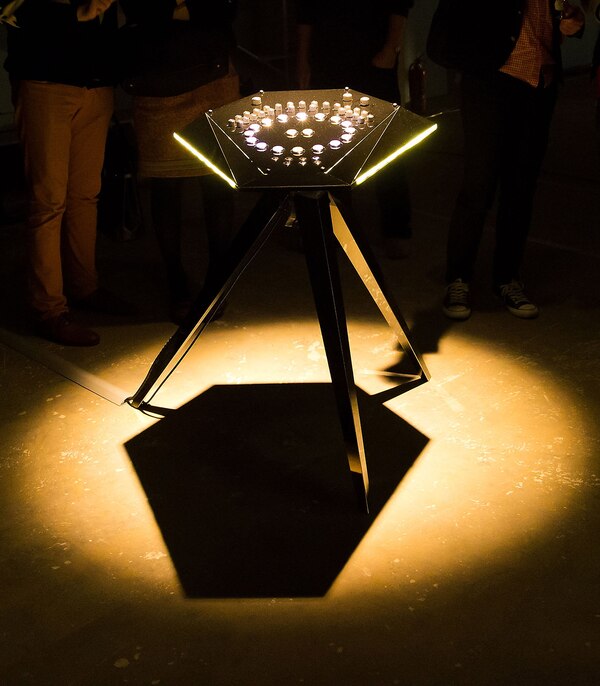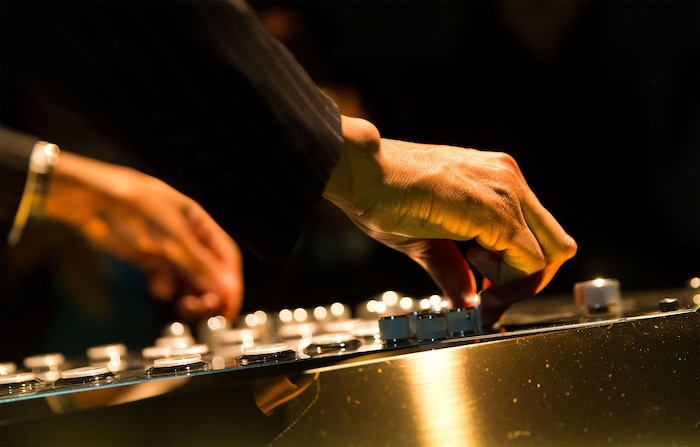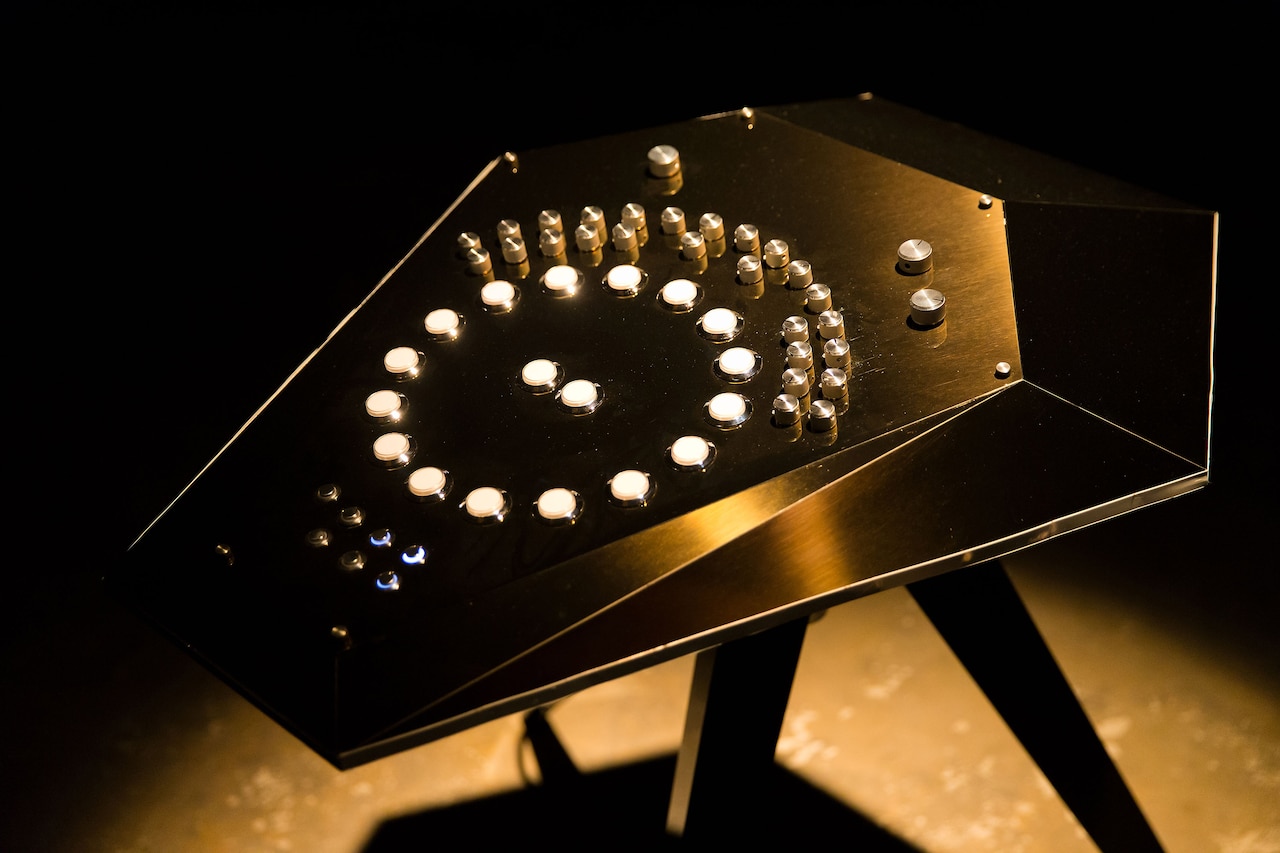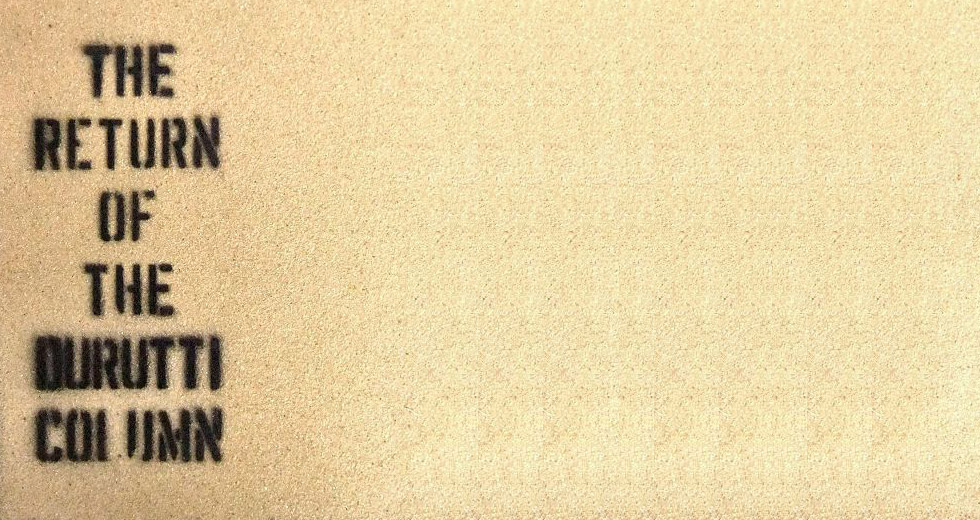How Jeff Mills Built A UFO Drum Machine

February 24th, 1942. A strange object is spotted in the night sky over Los Angeles. Air raid sirens are sounded across the county and a total blackout is imposed over the city. Fearing an imminent attack from Japanese forces, the US Navy open fire. When daylight eventually breaks and the smoke clears, the “enemy” is nowhere to be seen. The incident - ironically named “The Battle of Los Angeles” - is declared to have been a false alarm, and written off as a case of “war nerves.” A later report suggested the culprit was likely a stray metrological balloon.
Inevitably, such dissatisfying explanations fuel speculation, and this time of an extra-terrestrial cover-up. UFOlogists cite a photograph taken on the night, published in the Los Angeles Times, as evidence of a visitation, claiming that it shows spotlights directed at an alien spacecraft. Despite the Times itself debunking the specks of light that appear in the image as nothing more than illuminated bursts of anti-aircraft fire, the conspiracy theories have persisted.
Jeff Mills is one of the many who remain unconvinced by the official version of events. His latest project, a custom-built drum machine, was inspired by The Battle of Los Angeles. Named The Visitor, the instrument was unveiled this month in Tokyo after a six-year gestation. According to Mills, the design is based on the disputed Times photograph: its three-legged structure “represents the searchlights pointing upward towards [the] unknown figure, which is the unit itself.” It is, in a way, Mills’s own vision of what really was in the skies that night.
The Visitor was created with the help of Japanese designer Yuri Suzuki. The two met at Barcelona’s Sónar festival back in 2009, where Mills performed as The Wizard and Suzuki exhibited his work. Mills suggested they collaborate on the design of his upcoming album, The Occurrence. “He wanted to do something unique, something special with media, so we produced a hybrid format that works both as a record and CD,” explains Suzuki. When the pair met again in Chicago, Mills revealed to Suzuki an even more ambitious idea for their next project: “He told me one of his dreams was to make his own drum machine.”
True to his word, Mills sacrificed his oldest 909 for the project - the very one he’d used since his Underground Resistance days. “I felt guilty that we had to gut it,” says Suzuki.
Mills came to the right man; Suzuki is something of an expert when it comes to building unusual musical objects. He got his start as a designer in a madcap Japanese collective of artists and engineers called Maywa Denki (among the many bizarre inventions they’ve dreamt up in their Tokyo workshop are: an electronic harp shaped like a fish, a remote controlled guitar and a saxophone-like instrument made from six airhorns).
After moving to the UK in 2005, Suzuki went on to work on more conventional instruments for both Yamaha and Teenage Engineering, manufacturers of pocket-sized synths. In 2013, he designed and developed his own instrument, the OTOTO: part modular synth, part Raspberry PI.
As he tells me when I meet him in his east London studio, his instruments are intended to be accessible to those without any musical training. “I used to belong to a ska band in Japan. I got fired because I wasn’t very good - I couldn’t read any music. The instruments I’ve made are for dyslexic people like myself, who find reading notation difficult,” he explains.
His latest commission is, however, quite the opposite - a bespoke instrument for one man only. “Jeff wanted it to be very abstract at the beginning,” says Suzuki. Initially, Mills had intended The Visitor to be a more literal take on his source of his inspiration. The original plan was to create a drone-instrument hybrid that would be able to take off mid-performance, and hover above the audience before returning to him. Ambitious though the concept was, it proved difficult to realise. Instead, the pair decided to reimagine an instrument Mills was already very familiar with - the Roland TR-909 drum machine.
“There must always be destruction of the old to bring forth the new,” wrote Mills in the text that accompanied his Star People audio-visual performance in 2013. True to his word, Mills sacrificed his oldest 909 for the project - the very one he’d used since his Underground Resistance days. “I felt guilty that we had to gut it,” says Suzuki.
For the project’s engineers, Mike Vanis and Andy Sheen, rewiring a machine worth thousands of pounds second hand was daunting in itself - let alone one owned by Jeff Mills. “You can just go and order another one… we only had one chance to get it right,” says Vanis.

The transplant was not without complications. The analogue components of the 909 are unpredictable, making it a challenge to modify them without altering the original’s characteristic sound in the process. Even manufacturers Roland opted to completely digitise the 909 for its reissue last year rather than produce a replica. “Every time we adjusted something, we were scared to hear what would happen when we plugged it in,” says Vanis. Despite their efforts, when Mills first tested the machine he detected a change, much to the pair’s chagrin. “He said ‘It sounds different’ and we were like, ‘Oh god.’ Our faces dropped. But then he said, ‘I hoped that might happen,’ which was a relief.”
As for the exterior of The Visitor, its hard-edged chrome enclosure is, well, like something from another planet. The streamlined shape of the unit, co-designer Kohen Judd explains, was intended to make it seem like “it could fly away at any moment.” Grounded by a tripedal stand it looks slightly sinister, like an oversized metallic insectoid. Part War Of The Worlds, part Alien; it might have been sent here to conduct reconnaissance in advance of a full, invading force.
The Visitor’s modifications to the 909 are not just cosmetic however; they also serve a more functional purpose. After years of performing with orchestras, Mills wanted to transform the cumbersome drum machine into an instrument; the 909’s compact arrangement of buttons and fiddly knobs were never intended for live use.
Nor were they designed to withstand much force, as was evident when Suzuki received Mills’s worn down machine. “Jeff hits those buttons hard so it was really difficult trying to find replacements, I must have tried thirty different types,” he says. The only buttons which Suzuki could find, that would be able to withstand such a beating, were those used in arcade cabinets for fighting games.

But by far the most radical departure from the 909 is the circular interface of The Visitor. “Dance music is not linear, it’s about repetition, and I wanted the design to reflect that,” explains Suzuki. Partly, the idea was inspired by Mills’s music, which has often featured concentric arrangements as with his 1992 collaboration with Mike Banks as X-102, The Ring of Saturn. On a practical level, “the shape also makes sense because when you programme the 909 it loops,” adds Suzuki.
For Mills, The Visitor is the latest addition to an ever-evolving science fiction narrative that has played out through his live performances, art installations and, of course, his music. Last year he released Emerging Crystal Universe, the eighth instalment of his space odyssey Sleeper Wakes, which charts the travels of an intergalactic explorer. Like his film scores, the album is also a soundtrack - only this time, for a cinematic universe entirely of Mills’s own imagining.
Mills contends “the presence and acknowledgement of a Unidentified Flying Object acts as a cultural equalizer,” prompting the revelation that “we all share the same vulnerability and limitation.”
Concurrent to this on-going cosmic saga, Mills has been working on two other side-projects inspired by UFOs. Started in 2010, Mills’s Something In Sky sub-label began as a mysterious one-off release that featured a photograph of two children looking towards the skies, and track titles like “What Was It” and “It Went Westward.” Each subsequent release has been accompanied by this visual motif of people gazing at something tantalising out of shot. It would seem that Mills is more interested in the act of witnessing rather than the witnessed.
As he explains, the series was intended to “address the fear and uneasiness of witnessing something unknown and unrecognisable, but also something we cannot not rationalise. Something so elusive, or so advanced, where we are helpless but to only watch it in horror and amazement.” Mills contends, “the presence and acknowledgement of a Unidentified Flying Object acts as a cultural equalizer,” prompting the revelation that “we all share the same vulnerability and limitation. No matter what race, color, culture or amount of knowledge… That was the true message behind Something In The Sky.”
Something In The Sky diverged into another sub-label in 2012 with a released entitled Taken. Described as “the next chapter,” it suggested an abduction of some kind - perhaps the consummation of past SITS releases, although its lack of track titles gave no further clues. It’s not the first time that Mills has envisaged what a close encounter of the third kind might be like.
His 2008 album, Contact Special, imagined such an interaction, but from the opposite perspective. “The concept allowed me to explore the idea of music from the alien’s point of view,” says Mills, “from a position of curiosity or procedure. Not from astonishment or surprise.”
Like many of Mills ideas, music is only one dimension of Contact Special. It was initially produced for a performance at Tokyo’s Womb nightclub in 2005, in which Mills staged an alien abduction on his unwitting audience. As he explained to The Wire, the night was meticulously planned: “we would make a script of what would happen, from the time the doors opened to the time the club ended. Every hour was divided. A lighting scheme, a sound scheme and a special effects scheme were put in place, and at a certain point the abduction would happen.”
When Mills returned to the club in 2010 to perform Sleeper Wakes, he donned a spacesuit and built up anticipation for his arrival prior to the event with a series of dispatches, which were published online. “I very much look forward to returning to Earth at the end of the year to seeing and meeting everyone. I’m not sure I’m the same person I was then, after witnessing such an array of occurances [sic] in my travels. Nevertheless, my objective of exploring the Universe in search of new discoveries and possibilities in sound is coming closer to reality,” Mills writes in one of his logs.
After over two decades of performing with a 909 Mills has become a virtuoso player - making his decision to reinvent the machine a bold late-career move.
As his celestial travelogue suggests, Mills’s narratives are as much an exploration of inner space as outer. In his book, More Brilliant Than the Sun, Kodwo Eshun traces this concept of a sensory voyage through many works of Afrofuturism. These “Sonic Fictions,” Eshun writes, “turn your mind into a universe, an interspace though which you the headphonaut are travelling. You become an alien astronaut at the flight deck controls of Coltrane’s Sunship, of Parliament’s Mothership, of Lee Perry’s Black Ark, of Sun Ra’s fleet of 26 Arkestra’s, of Creation Rebel’s Starship Africa, of The JB’s Monaurail.”
Mills, too, belongs to this lineage, inviting us to accompanying him on his travels though the elaborately crafted backstories to his music. But they are also personal quests; allegories for his own ceaseless journeying which has led him to many new realms over the years. The Visitor marks Mills latest move into uncharted territory, and perhaps one of his most significant side-projects to date. After over two decades of performing with a 909 Mills has become a virtuoso player - making his decision to reinvent the machine a bold late-career move. The Visitor adapts the 909 to the way in which Mills has been performing of late, as additional piece within an orchestra.
“Similar to way of classical instruments, I wanted to have a machine that did one thing. That produced one sound. A player that I had to manage and operate in various way to extract the sound,” says Mills. As well as a forthcoming performance with the BBC Symphony Orchestra later this year, he also has plans to make a record with The Visitor. With a completely reconfigured layout, it will take some time first to become accustomed to the new interface.
Partly, there’s a sense that Mills is challenging himself, refusing to allow himself to succumb to the comfort of familiarity. He seems unsure of how long it might take to be able to navigate the instrument with the agility he previously demonstrated on the 909. “This, I do not know,” admits Mills, “but The Visitor was made as a gesture of new way of thinking, and the new time we sit in.”
Header image © Yuri Suzuki
